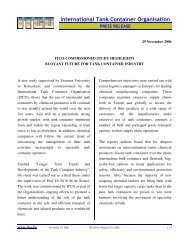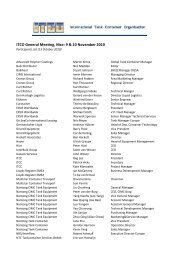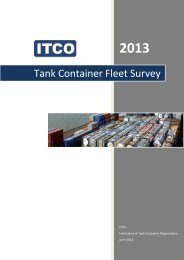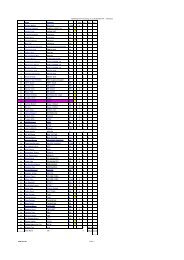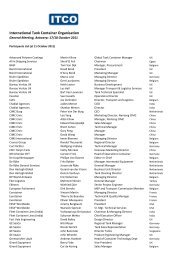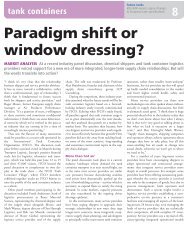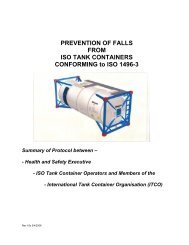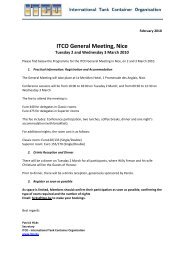Acceptable Container Condition - Itco.be
Acceptable Container Condition - Itco.be
Acceptable Container Condition - Itco.be
- No tags were found...
You also want an ePaper? Increase the reach of your titles
YUMPU automatically turns print PDFs into web optimized ePapers that Google loves.
<strong>Acceptable</strong> <strong>Container</strong> <strong>Condition</strong>ITCO ACC Manual, Issue 3 No.2 Dated 29 Septem<strong>be</strong>r 2008WWW.itco.<strong>be</strong>1
ContentsPageIntroduction 3Definitions 41. Cleanliness 52. Frame 63. Walkway and Ladder 104. Paintwork 105. Insulation and Cladding 116. Manway Assembly 137. Safety Relief Valves 158. Top Valves 169. Pressure Vessel (Tank Shell or Barrel) 1710. Bottom Valves 1911. Heating 2312. Miscellaneous 2413. Test 25Appendix A Cleanliness Certificate 27Appendix B Internal Inspection Report 28Appendix C Standard Seals and Gaskets 29ITCO Secretariatc/o FresonKorteveld 33090 OverijseBelgiumfreson@itco.<strong>be</strong> - administrator@itco.<strong>be</strong>Tel: +32 2 783 2270Fax : +32 2 783 2271Mob : + 32 475 79 81 94web : www.itco.<strong>be</strong> or www.tankcontainer.org2WWW.itco.<strong>be</strong>
IntroductionThis Tank <strong>Container</strong> Inspection Manual has <strong>be</strong>en prepared by theInternational Tank <strong>Container</strong> OrganisationIts purpose is to establish a basic minimum tank condition throughout theindustry and to assist in maintaining the excellent safety record of the tankcontainer in operation worldwide.It is designed for use where tank containers are transferred from the care andcustody of one party to another, such as <strong>be</strong>tween owner, operator, lessee, shipper,depot and carrier, and to give clear guidelines to the contractor responsible forrepairs. For example, these standards will apply at the 'on-hire' of a leasedcontainer and will equally apply at the 'off-hire'.This manual is not intended to supersede or take preference over specialrequirements, or specific agreements entered into <strong>be</strong>tween contracting parties.It is the absolute responsibility of the user to ensure that the tank containercomplies with regulations or material requirements specific to the cargo, to themethod of carriage or to the route over which the container is transported.It is also the user's responsibility to ensure that the container complies with theInternational Convention for Safe <strong>Container</strong>s (CSC), the customs conventions oncontainers and all other applicable conventions, laws, regulations and governmentrequirements.Confined Space WarningEntry into tank vessels should <strong>be</strong>undertaken only after compliance with all ofthe prerequisites required or recommendedby the health and safety authorities havingjurisdiction over both the location of thetank and the container itself.WWW.itco.<strong>be</strong>3
Definitions<strong>Acceptable</strong> and Not acceptable <strong>Condition</strong>sThe condition guide which follows lists the component parts of a tank containerand descri<strong>be</strong>s what is acceptable and what is not acceptable according to thestandards agreed by the ITCO.NOT <strong>Acceptable</strong> <strong>Condition</strong>Is damage which affects the safety, structural integrity, cargo-carrying capability,the ISO dimensions of the tank container or where repairs are improper or not incompliance with the applicable regulations:THIS TYPE OF DAMAGE MUST BE REPAIRED<strong>Acceptable</strong> <strong>Condition</strong>Is minor damage or fair wear and tear which does not affect any of the aboveconditions:NO REPAIR IS REQUIREDFair Wear and Tear'Fair Wear and Tear' is the age‐related deterioration of the container or any of itscomponent parts while <strong>be</strong>ing properly maintained and used for its intendedpurpose. Any deterioration resulting from improper use, improper maintenanceor lack of maintenance is not 'Fair Wear and Tear.'Replacement of leaking or contaminated seals and gaskets is a normal operatingrequirement and is not 'Fair Wear and Tear.'NOTES:ISome tank containers may <strong>be</strong> fitted with equipment which does notconform to the make and specification stated in the text. Where there isdoubt as to the suitability of this equipment please refer to the owner.IIIIIWhere it is necessary to replace a component, the replacement should <strong>be</strong> thesame or, if not available, of a <strong>be</strong>tter quality than it replaces.The drawings included in this manual are not applicable to all types of tankcontainers.4WWW.itco.<strong>be</strong>
Cleanliness1.1 InteriorNOT <strong>Acceptable</strong> <strong>Condition</strong>Previous cargo, contamination or odour.Discolouration or transferable stain which can <strong>be</strong> removed by the manualapplication of a plastic abrasive pad and/or solvent.Corrosion, pitting, grinding or gouges. (See Section 9).Missing or improper Cleanliness Certificate._______________________________________________________________<strong>Acceptable</strong> <strong>Condition</strong> Abrasion or scratches to finer than 120 grit polish equivalent.NOTE:When the tank is received into depot for ‘off-hire’ the depot must <strong>be</strong> in possessionof a valid certificate of cleanliness stating the proper shipping name and U.N.num<strong>be</strong>r of the last cargo carried in the tank.The Cleanliness Certificate must have the date of inspection later than the lastcargo or any internal work or internal cleaning.For man entry it is the responsibility of the depot supervisor to ensure that the tankcontainer is safe to enter. This may require an inspection for gas contamination orlow oxygen. (Gas Free Certificate).Tank containers are accepted for delivery into depot for off-hire only whenaccompanied by a Cleanliness Certificate. Tanks containers without validdocumentation must <strong>be</strong> considered unsafe and should not <strong>be</strong> inspected. ACleanliness Certificate issued by an independent surveyor is required for all tanksredelivered for off-hire. (See Appendix A).1.2 ExteriorNOT <strong>Acceptable</strong> <strong>Condition</strong>Previous cargo, contamination or odour.Oil, grease deposits.Road dirt reducing legibility of tank markings._____________________________________________________________________WWW.itco.<strong>be</strong>5
<strong>Acceptable</strong> <strong>Condition</strong>• Road dirt. (Except as stated above).NOTE :The valve and manlid spillage trays must <strong>be</strong> clean and free of cargo spillage. Checkareas of overspill for damage to paint and cladding and inspect drain tu<strong>be</strong>s forblockage.1. 3 Foreign MarkingsNOT <strong>Acceptable</strong> <strong>Condition</strong>• Hazard warning la<strong>be</strong>ls or cargo la<strong>be</strong>ls.• Non-standard la<strong>be</strong>ls or misleading marks.• Remnants of la<strong>be</strong>ls.• Insecure la<strong>be</strong>l holders.__________________________________________________________________________<strong>Acceptable</strong> <strong>Condition</strong>• Serviceable non-standard la<strong>be</strong>l holders.• Glue residue2 Frame2. 1 CornerPostsNOT <strong>Acceptable</strong> <strong>Condition</strong>Cuts or holes or gouges.Cracks or splits in welds or parent metal.Improper repairs..Dents or distortions of a formed or folded edge or face greater than 15 mm(0.6 inch) in depth irrespective of length of deformation.Dents greater than 10 mm (0.4 inch) and less than 15 mm (0.6 inch) indepth in excess of two per post.Dents greater than 10 mm (0.4 inch) extending over a length greater than300 mm (12 inch).Twisted or <strong>be</strong>nt or over-plated <strong>be</strong>yond the requirements of ISO.Corrosion affecting the structural strength of the mem<strong>be</strong>r.WWW.itco.<strong>be</strong>6
NOT <strong>Acceptable</strong> <strong>Condition</strong>_________________________________________________________________________<strong>Acceptable</strong> <strong>Condition</strong>• Dentsaboveor distortions not exceeding 15 mm (0.6 inch) in depth except as qualifiedWWW.itco.<strong>be</strong>7
2.2 Top and Bottom Side and End RailsNOT <strong>Acceptable</strong> <strong>Condition</strong>• Cuts, holes, gouges or splits.• Cracks in welds or parent metal.• Improper repairs.• Dents greater than 25 mm (1 inch).• Out of straight greater than 25 mm (1 inch) per 2 m (79 inch) length.• Distortion reducing clearance preventing operation of discharge valve.• Twisted or <strong>be</strong>nt outwards <strong>be</strong>yond the limits of the ISO corner fittings.• Severe corrosion.• Loose or missing fasteners.________________________________________________________________________<strong>Acceptable</strong> <strong>Condition</strong>• Dents not exceeding 25 mm (1 inch).• Dents in bottom face of bottom rails which do not affect any formed edge.NOT <strong>Acceptable</strong> <strong>Condition</strong>2. 3 Ancillary Bracing• Cuts, holes, gouges or splits.• Cracks in welds or parent metal.• Improper repairs.• Dents and distortions greater than 25 mm (1 inch).• Distortion reducing clearance preventing operation of discharge valve• Twisted or <strong>be</strong>nt outwards <strong>be</strong>yond the limits of the ISO corner dimensions.• Severe corrosion.NOT <strong>Acceptable</strong> <strong>Condition</strong>• Cuts, holes, gouges or splits.• Cracks in welds or parent metal.8WWW.itco.<strong>be</strong>
• Improper repairs.• Dents and distortions greater than 25 mm (1 inch).• Twisted or <strong>be</strong>nt outwards <strong>be</strong>yond the limits of the ISO corner dimensions.• Severe corrosion._____________________________________________________________________________<strong>Acceptable</strong> <strong>Condition</strong>• Dents and distortions less than 25 mm (1 inch).2. 4 Tank Bearer Supports and Load Transfer AreasNOT <strong>Acceptable</strong> <strong>Condition</strong>• Cuts, holes, gouges or splits.• Cracks in welds or parent metal.• Improper repairs.• Dents or distortion of a formed edge greater than 13 mm (0.5 inch).• Dents and distortions of the face greater than 20 mm (0.75 inch).• Severe corrosion.• Twisted or <strong>be</strong>nt outwards <strong>be</strong>yond the limits of the ISO corner fittings.NOTE:In all cases of damage to a tank <strong>be</strong>arer support the tank shell must also <strong>be</strong> inspectedfor damage. In all cases of corrosion to the tank <strong>be</strong>arer supports the section of the<strong>be</strong>arer attached to the shell <strong>be</strong>low the insulation must <strong>be</strong> checked for structuralintegrity. This will require local removal of insulation2.5 Stacking Supports / Miss Stacking PlatesNOT <strong>Acceptable</strong> <strong>Condition</strong>• Cuts, holes, gouges or splits.• Cracks in welds or parent metal.• Improper repairs.• Dents and distortions greater than 25 mm (1 inch).• Twisted or <strong>be</strong>nt outwards <strong>be</strong>yond the limits of the ISO corner dimensions.• Severe corrosion._____________________________________________________________________________<strong>Acceptable</strong> <strong>Condition</strong>• Dents and distortions less than 25 mm (1 inch).WWW.itco.<strong>be</strong>9
3 Walkway and Ladder AssemblyNOT <strong>Acceptable</strong> <strong>Condition</strong>• Insecure.• Cuts, holes, splits, sharp edges or dents affecting safety.• Distortions greater than 50 mm (2 inch).• Dents greater than 25 mm (1 inch).• Twisted or <strong>be</strong>nt outwards <strong>be</strong>yond the limits of the ISO corner dimensions.• Missing fasteners or electrolytic barriers._____________________________________________________________________________<strong>Acceptable</strong> <strong>Condition</strong>• Distortions smaller than 50 mm (2 inch) measured over not less than l mlength and not affecting safety.• Dents up to 25 mm (1 inch) and not affecting safety.• Cuts not affecting safety.4 PaintworkNOT <strong>Acceptable</strong> <strong>Condition</strong>• Paint removed by spillage of cargo.• Paint removed by improper handling.• Corrosion or paint abrasion equal to, or more severe than, Euro StandardRe4.____________________________________________________________________________<strong>Acceptable</strong> <strong>Condition</strong>• Superficial corrosion.• Light discoloration.• Light scuffs and scratches.Note :Paint damage and resulting corrosion must <strong>be</strong> repaired as part of routinemaintenance.WWW.itco.<strong>be</strong>10
5 Insulation and CladdingINSULATIO CLADDING5.1 InsulationNOT <strong>Acceptable</strong> <strong>Condition</strong>• Missing insulation material.• Saturation by water or cargo.• Improper repairs.• Deterioration by heat (burnt or baked).5. 2 CladdingNOT <strong>Acceptable</strong> <strong>Condition</strong>• Cuts, holes, cracks or splits penetrating the cladding thickness and allowingmoisture ingress.• Gaps in cladding and patch joints allowing moisture ingress.• Deterioration by heat (burnt or baked).• Insecure cladding or retaining straps.• Surface damage or staining of cladding due to cargo contamination.• Corrosion or pitting allowing moisture ingress• Improper repairs.• Distorted outwards <strong>be</strong>yond the limits of the ISO corner fittings.• Dents greater than 25 mm (1 inch)._____________________________________________________________________________<strong>Acceptable</strong> <strong>Condition</strong>• Distortion not affecting security nor allowing moisture ingress except asstated above.• Abrasion.Full <strong>be</strong>lly GRP patch on existing aluminium claddingNOTE:I. In all cases of damage to the cladding the tank shell, heating tu<strong>be</strong>s andelectrical components must also <strong>be</strong> checked.WWW.itco.<strong>be</strong>11
II. The following criteria will apply when assessing the type and extent ofrepair required. Use self colour polyester in-fill or overlay riveted patches(minimum 2 mm (0.08 inch) thick G.R.P. for G.R. P. cladding-minimum and0.9 mm (18 s.w.g.) Alum Alloy for Alum Alloy cladding in the same colour).Minimum patch size 150 x 150 mm (6 inch x 6 inch).WWW.itco.<strong>be</strong>12
6. 3 Dipstick and Calibration ChartNOT <strong>Acceptable</strong> <strong>Condition</strong>• Distortion or damage to the dipstick assembly preventing operation.• Non-stainless steel.• Contamination or corrosion.• Illegible or insecure.Note :Dipsticks may or may not <strong>be</strong> standard. When in doubt refer to the owner.14WWW.itco.<strong>be</strong>
7 Safety Relief Valves7.1 Pressure Only or Pressure Vacuum ValvesNOT <strong>Acceptable</strong> <strong>Condition</strong>• Contamination or corrosion.• Missing parts.• Distortion, damaged or worn threads affecting correct operation or security.• Leaks or incorrect pressure setting.• Missing or defective Customs sealing ring.• Improper repairs, seals or gaskets..................................................................................................................................................................<strong>Acceptable</strong> <strong>Condition</strong>• Missing dust plug.• PTFE or CF gaskets.7.2 Flame Arrestor Gauze (Where Fitted)NOT <strong>Acceptable</strong> <strong>Condition</strong>• Missing, if originally fitted.• Damage affecting operation.• Contamination.WWW.itco.<strong>be</strong>15
Note :Flame arrestors are not necessary on non-hazardous tanks or on Pressure OnlyValves.7.3 Bursting Disc (Where Fitted)NOT <strong>Acceptable</strong> <strong>Condition</strong>8 Top Valves• Leaks or incorrect pressure rating.• Contamination or corrosion.• Broken disc.• Improper parts.• Damaged pressure gauge affecting correct operation.• Missing tell tale / pressure gauge.Note :Bursting discs may or may not <strong>be</strong> fitted as standard. Refer to owner if in doubt.Many tanks have bursting-disc flange assemblies fitted in series with the reliefvalve for the fitting of bursting discs if required.8.1 Airline (Vapour) ValvesNOT <strong>Acceptable</strong> <strong>Condition</strong>• Leaks.• Contamination or corrosion.• Damage or distortion of valve or screwed fittings affecting correct operation.• Incompatible Material*• Missing Customs sealing ring.• Defective pressure gauge where fitted.• Missing outlet cap or seal or retaining wire.• Improper repairs, seals or gaskets.<strong>Acceptable</strong> <strong>Condition</strong>• SWR or PTFE airline cap seals.• Caps of non-corrodible material.Note :If no valve is fitted, airline screw cap seals must <strong>be</strong> of the full face type.WWW.itco.<strong>be</strong>16
* Refer to notes under “Fair wear and tear “8.2 Top OutletNOT <strong>Acceptable</strong> <strong>Condition</strong>• Leaks.• Contamination or corrosion.• Damage or distortion affecting correct operation or sealing.• Missing or defective parts.• Improper repairs, seals or gaskets.• Incompatible Material *.• Non-standard parts. (Refer to owner).• Missing Customs sealing ring* Refer to notes under “Fair Wear and Tear “8.3 Syphon Tu<strong>be</strong> (where fitted)NOT <strong>Acceptable</strong> <strong>Condition</strong>• Contamination or corrosion.• Incompatible Material *.• Damage or distortion affecting correct operation or sealing.* Refer to notes under “Fair Wear and Tear “9 Pressure VesselNOT <strong>Acceptable</strong> <strong>Condition</strong>• Leaks.• Cuts, cracks.• Defects to welds or parent materials.• Gouges, scratches and badly executed grinding, deeper than 0.1 mm (0.004 inch).• Excessive grinding or other metal depletion which reduces the shell thickness toless than the minimum.• Grinding coarser than 120 grit.• Corrosion or pitting which reduces the shell thickness <strong>be</strong>low the required minimumor creates contamination traps.• Stress corrosion.• Improper repairs or non-standard fittings.WWW.itco.<strong>be</strong>17
• Sharp indentations, creases or dents causing the elastic limit of the material to <strong>be</strong>exceeded resulting in permanent deformation.• Dents greater than 6 mm (0.25 inch) to the top third of the tank shell.• Dents greater than 10 mm (0.4 inch) to the bottom two thirds of the tank shell.• Vacuum ring distortions greater than 15 mm or 50% of the thickness , whichever issmaller<strong>Acceptable</strong> <strong>Condition</strong>• Gradual distortions measured over the length <strong>be</strong>tween exterior stiffeners of lessthan 10 mm (0.4 inch) in bottom two thirds or less than 6 mm (0.25 inch) in topthird of tank shell.• Light abrasions or scratches to 120 grit polish equivalent or finer.Superficial pitting with no resulting contamination traps see type A hereafterPitting and PorosityAll pitting must <strong>be</strong> reported by type, area and position on the chart shown inAppendix B. An investigation must <strong>be</strong> carried out to ensure that cavity pitting is notpresent and that the pitting is not masking stress corrosion. The investigation willinvolve localised polishing of the surface followed by visual examination with the aidof a magnifying glass and dye penetrant.Fig 5Type A – Shallow Clean PitType B – Crater or PinholeType C – Pore or Cavity18WWW.itco.<strong>be</strong>
NoteMandatory hydrostatic retesting is required after all welded repairs to the tank shell10 Bottom Valves10.1 Foot ValveNOT <strong>Acceptable</strong> <strong>Condition</strong>• Leaks.• Contamination or corrosion.• Damage or distortion affecting correct operation or sealing.• Improper repairs, seals or gaskets.• Customs sealing ring missing.• Incompatible Material*.* Refer to notes under “Fair Wear and Tear “NoteFoot valve to tank flange gaskets must <strong>be</strong> PTFE envelope CF10.2 Bottom Outlet ValveNOT <strong>Acceptable</strong> <strong>Condition</strong>• Leaks.• Contamination or corrosion.• Damage or distortion affecting correct operation or sealing.• Improper repairs, seals or gaskets.• Customs sealing ring missing.• Incompatible Material*.10.3 Outlet BlankNOT <strong>Acceptable</strong> <strong>Condition</strong>• Leaks.• Contamination, or corrosion19WWW.itco.<strong>be</strong>
• Customs sealing ring, missing• Damage or corrosion affecting operation.• Incompatible material*.* Refer to notes under “Fair Wear and Tear “Note :Where renewal is necessary bolts should <strong>be</strong> stainless steel. Replacement gasketsshould <strong>be</strong> PTFE envelope CF or solid PTFE.WWW.itco.<strong>be</strong>20
Bottom Outlet ValveItem Description Item Description1PTFE/CF valve to tank gasket11Viton ‘O’ Ring2Bayonet cap12PTFE ‘O’ Ring 2 off3Spring13Stuffing clamp4Pressure plate14Capscrew – M6 3 off5Fortyte ‘O’ Ring15Operating handle6Clamp Plate16Screw – M67Screw ‐ M6‐ PTFE 3 off17Washer8PTFE/CF valve to ball valve gasket18Crank block assembly9PTFE spindle bush19Sleeve10Spindle20Body10.4 Screwed Outlet CapNOT <strong>Acceptable</strong> <strong>Condition</strong>• Leaks.• Contamination or corrosion.• Missing parts.• Non-metallic, or a material which is not corrosion resistant.• Damaged or improper screw threads.21WWW.itco.<strong>be</strong>
• Broken or missing retaining wire or chain.• Damage affecting operation._____________________________________________________________________<strong>Acceptable</strong> <strong>Condition</strong>• SWR seals.NoteReplacement caps must <strong>be</strong> secured by a chain.Butterfly Valve Top and Bottom Outlet and Vapour Return ValveItem Description1Handle LeverItem Description13Gland Plate Washer2Handle Pin14Gland Plate Nut3Handle Screw15Gland ‘O’ Ring4Handle Spring16Flanged Body5Gland Plate Screws17Gland Plate Washer6Handle18Gland Plate Nut7Gland Plate19Fixed Pivot8Gland Pin20Bottom Bearing9Gland Ring21Closing Plate10Gland ‘O’ Ring22Main Seal11Shaft23Locating Ring12Gland Ring24Seal Plate10.5 Remote Emergency Closure10. 5 Remote Emergency ClosureNOT <strong>Acceptable</strong> <strong>Condition</strong>• Damage rendering remote closure inoperable.• Seized.• Broken thermal closure (when fitted)• Insecure.22WWW.itco.<strong>be</strong>
11 Heating11.1 Steam Tu<strong>be</strong> and CapNOT <strong>Acceptable</strong> <strong>Condition</strong>• Leaks.• Damaged screwed fittings.• Missing dust caps.• Missing chain or cable.• Distortions greater than 50% of the steam tu<strong>be</strong> depthNote :In all cases of damage the steam tu<strong>be</strong>s must <strong>be</strong> pressure tested. Defective steam trapsshould <strong>be</strong> removed, replacement is not required.11.2 ThermometerNOT <strong>Acceptable</strong> <strong>Condition</strong>• Not operating correctly.• Broken facia or dial.• Missing or insecure.• Improperly fitted...................................................................................................................................................<strong>Acceptable</strong> <strong>Condition</strong>• Condensation which does not prevent legibility.11.3 Electric HeatingNOT <strong>Acceptable</strong> <strong>Condition</strong>• Non-operational.• Missing parts.• Damage or deterioration that may allow moisture entry to control boxes orelements.• Insecure components, cables or terminals.• Corroded terminals or components.• Improper repairs.• Earth leakage less than 1 megohm.WWW.itco.<strong>be</strong>23
NoteAll parts must <strong>be</strong> well-maintained and fully-operational. An electric function test isrequired at off-hire and on-hire for every electric heated tank.12 Miscellaneous12.1 Decals and Data PlatesNOT <strong>Acceptable</strong> <strong>Condition</strong>• Insecure.• Missing or illegible plates.• Missing, illegible, obscured or partly missing decals and logos.• Twisted or <strong>be</strong>nt <strong>be</strong>yond limits of ISO._____________________________________________________________________<strong>Acceptable</strong> <strong>Condition</strong>• Scuffs.• Dents except as stated above.Note :All plates and decals required by applicable regulations must <strong>be</strong> in place. Refer toowner for details of the data plates and decals to <strong>be</strong> fitted.12.2 Document HolderNOT <strong>Acceptable</strong> <strong>Condition</strong>• Missing or defective.• Insecure.• No drain hole.• Water filled._____________________________________________________________________<strong>Acceptable</strong> <strong>Condition</strong>• Non-standard type.12.3 Compartments and Compartment LidsNOT <strong>Acceptable</strong> <strong>Condition</strong>• Non-operational.• Damaged.• Twisted or <strong>be</strong>nt <strong>be</strong>yond the limits of the ISO corner fittings.24WWW.itco.<strong>be</strong>
• Splits or tears.• Cargo residues, dirt, sundry waste.• Blocked, damaged, missing drain tu<strong>be</strong>s.13 Test12.4 Earthing (Ground) LugNOT <strong>Acceptable</strong> <strong>Condition</strong>• Damaged.• Missing.• Painted.13. 1 Air Leakage Test• The tank must <strong>be</strong> pressurized with air to 1 bar (15 p.s.i.g.) and all fittings andflanges checked with liquid soap at off-hire.• Leak checks to 1.0 bar (15 p.s.i.g.) are required to all tanks as part of the completedrepair inspection.• Where tanks are stored in depot for periods greater than six months from the timeof the completed repair inspection, a repeat leak test is required prior to delivery.13.2 Hydraulic Test (after repair)• Mandatory retesting is required after all welded repairs to the shell of hazardoustanks (see applicable regulations.).Equipment Necessary for Mandatory Hydraulic TestWWW.itco.<strong>be</strong>25
13.3 Mandatory Tests 5 Year or 2 ½ Year• Hazardous cargoes may only <strong>be</strong> transported in tank containers which have a valid 5year or 2 1/2 year mandatory test certificate.• Ensure by inspecting the Data Plate that a test is not required.APPENDIX AITCO FORMAT26WWW.itco.<strong>be</strong>
CLEANLINESS CERTIFICATETANK CONTAINER CLEANLINESS SURVEY REPORT(Certificate invalid if not fully completed)Survey Company Name and Address ....................................................................................................................................................................................................................................................................Tank <strong>Container</strong> Serial No ........................................................................................................................Inspection Date ............................................................... Inspection Time ...........................................Inspection Location ...................................................................................................................................Cleaning Co .................................................. Cleaning Procedure............................................................Last Cargo Carried.................................................................................... UN No ...................................(Statement of last Cargo was provided by ................................................................................................)EXTERIORYes NoFrame, tank and walkways free of contamination and cargoManlid and valve compartments free of contamination and cargo Yes NoSerial num<strong>be</strong>rs and statutory markings legible Yes NoCargo la<strong>be</strong>ls removed Yes NoINTERIOREntry made into tank by surveyor Yes NoFree from odour Yes NoClean and free from all cargo and contamination Yes NoFree from corrosion or pitting (if no, report details <strong>be</strong>low) Yes NoDry Yes NoVALVES/FITTINGS free from all cargo and contaminationValves Yes NoManlid seal Yes NoSyphon Tu<strong>be</strong> Yes NoSpillage Drain Tu<strong>be</strong>s clear Yes NoGas free Entry Permit issued Yes NoREMARKS: ...................................................................................................................................................................................................................................................................................................................................................................................................................................................................................A thorough visual examination has <strong>be</strong>en carried out and the interior of the tank, valves and fittings arefree of contamination, previous cargo and odour. The tank is clean and dry.Name (Print) ............................................ Signed ............................................Date ................................APPENDIX BITCO FORMAT27WWW.itco.<strong>be</strong>
TANK SERIAL NO.Location:Inspected By:INTERNAL INSPECTION REPORTLAST PRODUCT:Ref. No. :Date:Order No.:FrontRearName (Print) Signed DateAppendix C Standard Seals and Gaskets28WWW.itco.<strong>be</strong>
The seals and gaskets <strong>be</strong>low are listed for guidance only. Many other materials existwhich may <strong>be</strong> used as seals for standard cargoes or specified to obtain compatibilitywith special cargoes.WWW.itco.<strong>be</strong>29



